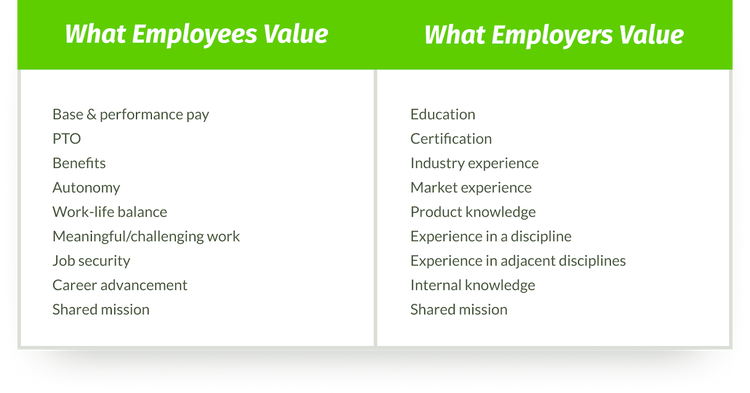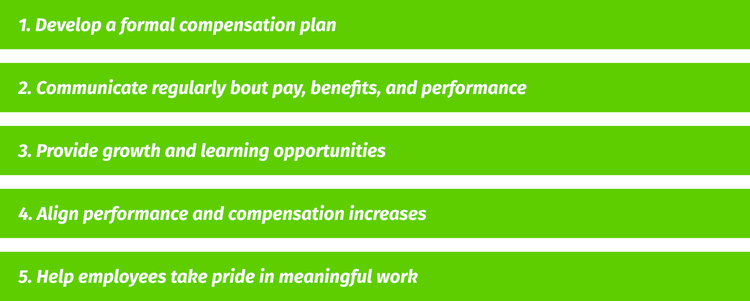How to Make Employees Feel Valued
What do you value about your employees? The list is probably extensive: you value their insights, their collaboration, the thousands of ways their experience and knowledge improve your organization and set it up for continued success. All of these translate into healthy finances and growth, helping your organization achieve its mission.
But do you show your employees how much you value them? We often use the word “value” to mean measuring worth in amounts of money, and while money is important, it’s just one of the ways you can show employees your organization values them. Focusing solely on money can lead to dissatisfaction on both sides as employers question whether employees are worth the investment and employees question whether their employers recognize their true value.

But when employers take a comprehensive look at their employees’ needs and emphasize the full value of their benefits, it leads to a better alignment between the employer and employee.
How should you make your employees feel valued at work? The best answer is simple: every way you can. Consider these five steps to help you get started:

Step One: Develop a Formal Compensation Plan
How your organization pays its employees can say a lot about your organization’s values. Does your organization know how its compensation compares to the market? Are you aware of how your employees feel about their compensation and the culture of rewards at your organization? After all, your employees can talk to peers, take online salary surveys, or browse employer review sites to understand their value in the market and decide whether you’re paying them what they’re worth.
Developing a compensation plan and remaining consistent sends the message that your organization has done what it takes to understand the job market and each employee’s place in it.
Your compensation strategy should answer these three key questions:
1. What talent market(s) do you intend to use for comparison for your organization?
Many factors go into determining your organization’s talent markets, including:
- Industry
- Size
- Location
- Specialty positions
The markets you select should reflect where you compete for talent, not business. Talent markets should provide context for your specific salary decisions. You may want to use more than one market to cover all your jobs. For example, hospitals may use different talent markets for their office and clinical staff. They may compete in another market for their physicians. Software companies may use one market to hire general business roles like finance and marketing and another market for more competitive roles like data scientists.
2. What are your organization’s competitive limits?
It’s important to attract talent with your compensation package, meaning that your compensation should be appropriately competitive for your market. But in many cases, exceeding the market average (or not sticking to your established salary ranges) leads you to pay too much for your talent.
Not only does this hurt your personnel budget, but it can also lead to salary discrepancies between longer tenured and newer employees. If your new employees earn more than your current employees with similar job descriptions and comparable experience, it sends the message that negotiation skills (or worse, gender or race) are more important than performance or loyalty. Also, hiring employees at the top of their price range can lead to dissatisfaction down the road if you can’t afford to increase their salary during subsequent review cycles.
3. Which behaviors do you want to reward with your compensation dollars?
An effective compensation plan avoids sending unintended messages through a clear connection to your organization’s values and goals. You can choose to reward any combination of performance, results, tenure, experience, or specific skills. Just make sure that what you choose to reward reflects the goals of your organization. For a deeper dive into how to develop a robust, data-based compensation plan, check out PayScale’s ebook: 5 Easy Steps to a Smart Compensation Plan.
Step Two: Communicate Regularly About Pay, Benefits, and Performance
Clear communication on pay and performance is another way to help your employees feel valued at work. These conversations help take your compensation plan from theory to reality, both in employees’ minds and their resulting performance. The key is to help your employees stay motivated.
Think of it this way: When was the last time you thought about the wonders of your dental insurance? Likely, it’s the last time you went to the dentist for a routine cleaning, and even then, probably only when the receptionist told you whether or not you have a copay. But if you then received a notice that your insurance only paid for half the cost of that visit, wouldn’t you be surprised and dissatisfied?
Similarly, pay and benefits can fade into the background of daily work life without regular communication. Psychologist Frederick Herzberg developed a two-factor theory of motivation, where he found that what employees want from the workplace can be separated into two categories: elements that reduce dissatisfaction and elements that increase satisfaction.

Your compensation and benefits package sets up certain expectations in your employees’ minds; when they accept a position with your organization, they adjust their lives accordingly.
But signing the offer letter doesn’t put an end to your employees’ expectations. As life continues, your employees will expect their basic support to cover changes in their lives, whether that’s starting a family, pursuing a hobby, or volunteering in their communities.
Without regular communication, these changes in expectations can outpace the reality of the situation, leaving employees dissatisfied. This is likely one of the reasons that Payscale’s research found that even employees paid above the market rate for their role think they’re underpaid.
On the other hand, the research also found that 82 percent of employees who had salaries lower than the market average felt satisfied with their work—as long as they received clear communication about the reasons for the smaller paycheck.
For more guidance on how to communicate pay decisions with employees, including talking points for a variety of comp scenarios, check out this guide: Everything You Need to Know About Communicating Pay.
Step Three: Provide Growth and Learning Opportunities
This leads to the next step on how to help your employees feel valued: provide growth and learning opportunities. As your employees’ expectations change, you need to make sure they know your organization has a plan to help them continue to make their lives better. Richard Branson summed it up:
Train people well enough so they can leave, treat them well enough so they don’t want to.
– Richard Branson
This doesn’t mean your organization needs to pay for everyone’s graduate degree. In fact, recent research from BambooHR and HR.com on career development found that only 18 percent of organizations with top-notch career development programs listed corporate university education as an effective source of career development.
Instead of treating employee development as an expensive event, treat it as an ongoing process. Change in your employees’ lives is also ongoing, and they have to decide whether to re-engage with your organization or look elsewhere to meet their personal and professional goals. Having regular conversations with each employee about their performance shows employees that your organization is interested in their progress and success. There are several ways you can start and continue this conversation.
Give Individual Feedback
First, set up a framework for both formal and informal feedback. Holding regular one-on-one meetings gives employees and managers a chance to open up about their recent challenges and successes without the pressure of compensation hanging over the conversation. Employees get the reassurance that their performance is acceptable, and managers can respond to areas where employees need additional support.
As employees open up about performance, they develop the skill to deliver informal, in-the-moment feedback about their daily work efforts. This can include constructive criticism and group recognition for a job well done. As these feedback efforts continue, employees learn effective career skills from each other and their capacity improves.
Communicate on the Organizational Level
It’s also important to promote regular communication at the organizational level. BambooHR uses regular monthly meetings to provide challenges to employees based on company values. For example, one challenge asked employees to spend the first five minutes of each day planning out their tasks, and then reporting the information to their High Five partner. Another challenge asked employees to commit to 15 minutes of physical activity each day, whether through walking meetings, breakroom calisthenics, or a lunchtime volleyball match.
Inform Employees About Benefits
Group settings are also a great opportunity to promote any underutilized benefits in your benefit package. BambooHR has financial advisors from our 401(k) program come in each month and help newly onboarded employees start planning their future now, rather than waiting to promote these benefits during the next open enrollment period.
These examples illustrate how principles taught at work can influence life outside work. Personal planning skills, health, and financial security have benefits well beyond office hours.
Step Four: Align Performance and Compensation Increases
Of course, employees aren’t just looking for personal learning and growth. They also want reassurance that their compensation will grow as they do. Another way to help employees feel valued at work is to tie compensation increases to clear performance measures. This helps employees understand the big picture while also heading off dissatisfaction and disengagement.
Here’s one striking statistic from Payscale’s recent research into the relationship between raises and retention: 50 percent of employees who asked for a raise and got one still planned on seeking a new job.

As Rusty Lindquist, Vice President of Thought Leadership at BambooHR, put it: “If your employees have to ask you for a raise, then they’re already starting to disengage from your organization.”
This returns to the strategy behind your compensation plan. Instead of limiting the conversation on compensation to what you pay employees, make it clear why your compensation plan pays what it does. Employees should know when to expect a compensation review, management should identify progress, and the organization’s leadership should use performance information to find internal candidates to step into expanded roles as they come up.
That’s because continual performance management helps employees develop confidence in your compensation plan. So when the time comes to review compensation, they know that their future with the organization is based on their actual performance, rather than on politics or having a big win right before the annual review.
If you want some ideas and strategies for building a pay-for-performance culture, check out this guide: Using Compensation to Motivate Performance.
Step Five: Help Employees Take Pride in Meaningful Work
Refining the first four steps leads to the final level for how to make employees feel valued at work: ensuring that they take pride in their skills and their knowledge. When you do this, you will find that people will start to share their insights and become loyal to your company rather than to their paychecks.
But how do you instill a sense of pride in your employees? You do it by laying out your company goals and communicating honestly with employees about the challenges your business is facing. When you let employees know that the company needs them for important tasks that only they can perform successfully, they will rise to the occasion.
Sometimes, what the management team feels will motivate and inspire their employees is very different from what employees care about. Instead of assuming you know what they want, ask them what will motivate or instill pride in them. This will give you insights into employees’ intrinsic motivations, which can be far more effective at motivating them than money.
3 Takeaways for How to Make Employees Feel Valued at Work
Helping your employees feel valued is a continuous process, in which open communication and genuine interest in your employees’ aspirations feature prominently:
- A compensation plan explains the support you provide.
- Regular, appropriate communication helps employees align their experience with your compensation plan.
- Opportunities for growth show that your organization is willing to invest in your employees’ future.
As you take action, you can achieve harmony between what your employees value from your organization and what your organization values from your employees.
Your employees will come to work understanding why they do what they do. And with their comprehensive needs satisfied, your employees will give their best, letting your organization reap all the rewards of employee engagement.